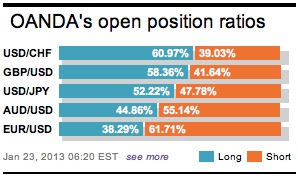Market moves have been fairly muted as investors await more news on the US debt ceiling. A bill to extend borrowing was introduced by the US Republican Party leaders on Monday and is expected to be approved by the US House of Representatives later today. Until then, most asset classes’ ranges will surely remain intact. Euro-peripheral yields are trading close to flat; following yesterday’s well-received Spanish issues.
On the data front, UK calendar releases hogged the limelight early morning, while the rest of the UK watched Prime Minister Cameron give a speech on whether his country should remain within the EU. He indicated that the UK’s national interest was best served in “a flexible, adaptable and open EU” and it “would be best that the UK was in it.” He has vowed to hold a general referendum before his term ends within 30-months.

The Bank of England MPC minutes were every bit as interesting as his speech. Published earlier this morning, it revealed that policy makers voted unanimously to leave the O/N benchmark rate at +0.5%. It was not a surprise; the surprise was the rhetoric surrounding more bond buying. Agreeing that more asset purchases may lower interest rates, there was a question mark surrounding whether it boosted overall consumer demand. Is this a sign that the “Old Lady” was backing away from further stimulus? Rate setters obviously agree that there is scope for further AP for growth purposes, however, how much of a killer punch does it really pack? The market guess is that policy makers are now looking at alternative ways to boost nominal demand to encourage the UK to spend more!
Despite the UK demand dilemma, British employment numbers remain encouraging. The “official, international definition of unemployment” has now fallen for ten-consecutive months, falling -37k in the three-months to the end of November. The unemployment rate has eased to +7.7%, the lowest three-month total in nearly four-years. Even the number of people in employment rose +90k to +29.68m, the highest level in nearly 40-years. The overall improvement was provided by a healthy rise in “full-time” employment. This upbeat data seems to be crossing swords with many analysts expectation for this Friday’s UK GDP data. The market is looking for the British economy to have contracted in Q4. We will have to see if this dilemma is holding true!
The future BoE Governor is front and center at a new time this morning. At 10am EST, Governor Carney, currently at the Bank of Canada, will release Canada’s official rate announcement. The market expects the BoC to stay on hold at +1.0% and perhaps downgrade its estimates of GDP and CPI in Q4 2012 and for this year’s Q1. If so, this would be very much in line with the disappointing tone of recent activity data. Very few observes’ expect Governor Carney to deviate from the bank’s current hawkish stance. It’s basically there to observe and prevent excessive household borrowing, especially with regard to housing. Currently for the loonie (0.9910), the short trade is looking better as the rejection from yesterday’s top extends further south as we move stateside.

Remaining with the Central Bank theme, the spotlight is still focused on the ECB’s announcement on the timing of the LTRO repayments. The market should know something on this matter this coming Friday. Analysts note that “Banks that accessed the 3-year LTRO facility a year ago were given an early repayment option, and the first weekly repayment date is set for 30 January.” The ECB is expected to announce the amount to be repaid and the number of counterparties repaying the following week. Going forward, this course of action and schedule should be repeated on a weekly basis. A first Q1 estimate is around +EUR200b and any evidence of a low repayment amount could provide the catalyst for a near-term downward correction for the EUR.

Despite all of the G10 JPY crosses looking short term bearish, the single currency remains firmly steadfast in its technical range. The fresh day range in the European session stretches from 1.3285 to 1.3344, with no obvious driver for either directional move. Long EUR traders remain intact and in play, looking towards the recent long-term objective to retrace the 2011-12 decline (1.3490). The long stop-losses are comfortably placed below the 21 DMA of 1.3230.

Other Links:
Is The Euro Relying on Excuses?
This article is for general information purposes only. It is not investment advice or a solution to buy or sell securities. Opinions are the authors; not necessarily that of OANDA Corporation or any of its affiliates, subsidiaries, officers or directors. Leveraged trading is high risk and not suitable for all. You could lose all of your deposited funds.


